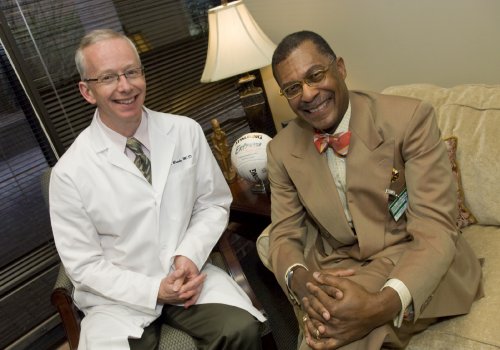
Donald Brady, M.D., left, Andre Churchwell, M.D., and colleagues are working to encourage diversity at Vanderbilt and among the nation’s medical community. (photo by Dana Johnson)
VUSM’s many diversity efforts showing dividends
Vanderbilt is emerging as a leader in the effort to diversify the ranks of medical residents and faculty at medical centers across the country.
Andre Churchwell, M.D., associate dean for Diversity in Graduate Medical Education, and Donald Brady, M.D., associate dean for Graduate Medical Education, presented a discussion session on the topic at the recent Association of American Medical Colleges (AAMC).
Now they say they are ready to work to make Vanderbilt a national example in the quest for a more diverse medical community.
“We will try to institute programs to help us carry out our efforts to increase diversity here at Vanderbilt,” Churchwell said.
“But we would also like to carry along the conversation nationally of underrepresented minorities in medicine, specifically in graduate programs and in medical school faculty.”
Brady and Churchwell have put together a new system and infrastructure to address concerns they say are critical to ensuring a greater depth of diversity at Vanderbilt University School of Medicine.
They say they are grateful for support from Harry Jacobson, M.D., vice chancellor for Health Affairs, Jeff Balser, M.D., Ph.D., associate vice chancellor for Health Affairs and dean of the School of Medicine, former dean Steven Gabbe, M.D., George Hill, Ph.D., associate dean for Diversity in Medical Education, and Bonnie Miller, M.D., senior associate dean for Health Sciences Education.
“Diversity has long been a top priority for the School of Medicine and through the efforts of Dr. George Hill and many others we've made great strides in that area with our medical students,” said Balser.
“Now, Drs. Churchwell and Brady are working to ensure that Vanderbilt becomes a national leader in resident diversity. I'm tremendously proud of their dedication to this initiative.”
“There have been programs in place to diversify the medical school population since the 1960s, but today we see an energy gap with the house staff (residents) and faculty. We were concerned that more graduates seem to be going into community hospitals than academic medical centers,” Churchwell said.
Numbers representing the diversity of residents and medical school faculty are not well documented across the country.
Brady and Churchwell did a little number crunching on their own and with friends from University of Michigan and University of Alabama. They found that about 7 percent of residents and 6 percent of faculty are underrepresented minorities.
Churchwell estimates that less than 3 percent or 4 percent of medical school faculty across the country are people of color.
“Increasing the diversity of our house staff will increase the diversity of our faculty over time,” Brady pointed out. “We need to keep these bright people in the university tract.”
Brady and Churchwell are not working toward a specific percentage goal for underrepresented minority house staff and faculty just yet. For now they are setting up Vanderbilt's program, and looking to present the concept to regional and national groups.













